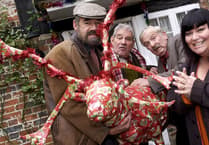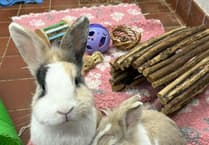Meet Ginger who, at the grand old age of 15, has just spent his first Easter away from a home environment.
He lived all his life with one owner, who sadly died earlier this year. Since there was no one in the family who could take care of Ginger, he came to us.
He is a very placid and gentle cat, and spends most of his time curled up in a ball sleeping. He has sole use of one of our socialisation rooms, and thoroughly enjoys spending time with the volunteers who visit him – purring loudly and giving them cat kisses.
Ginger has been recently diagnosed with mild arthritis and spondylosis, which sometimes makes him a little unsteady on his back legs. Otherwise, he is good health.
He will require medication for the rest of his life, which the MSPCA will pay for, and he will need a new owner who is able to administer tablets and who can take him to vet appointments.
His retirement home could have other cats in it, and given Ginger is so laid back we’re pretty sure he would cope with a well-behaved dog too.
He has always had access to the outdoors, but his hunting days are over and so he’ll live in relative harmony with garden birds.
Which is good news for the migratory birds that will be appearing over the next few weeks – birds such as the swift.
Overcoming starvation, exhaustion and storms, this amazing little creature will return to our shores mid-April.
They will have flown hundreds of miles from Southern Africa at a cruising speed of 22mph, often covering more than 200 miles a day. Not bad going for such small birds. They either cross the Sahara or navigate their way along the coastline of Africa.
Once they’ve survived this challenge they begin their journey over Spain, climbing high over the Pyrenees and travelling through Western France before hitting UK soil.
These little birds spend most of their lives on the wing – they catch insects in the air, and drink by swooping low over water to take a sip.
They even sleep whilst flying (the only bird known to do this). Flying at a high altitude of 10,000 feet (the same as a small plane) seems to help them navigate whilst they are asleep, using wind drift and automatically adjusting their flight to stay on a specific course.
Swifts have the perfect bodies for being air born for so long, with their long wings and slender bodies. Nor are they encumbered by long legs (in fact their legs are so short they can’t take off from the ground) or tail feathers, which is the best way to tell them apart from swallows.
Swallows have long tail streamers, red throats and glossy blue-black backs, and although similar in appearance to the swift they are completely unrelated. They are known as the ‘bird of freedom’ because they cannot endure captivity and will only mate in the wild.
The house martin can be identified by its slightly curved tail, and by its white underbelly and rump which can just about be glimpsed as the bird flashes by in its mission to catch insects.
Swallows, swifts and house martins traditionally nested in cliffs, caves and hollow trees, but they have adapted to urban environments and they will make their nests under the eaves of buildings.
Their nests are carefully crafted out of mud and are cup or oval shaped, but sometimes they break apart, or sometimes a hatchling can slip over the edge.
If you find a hatchling on the floor and you can’t put it back in the nest, pop it in an empty margarine tub and place it as high up as possible (out of the reach of cats) so that the parents can continue to feed it.

.jpeg?width=209&height=140&crop=209:145,smart&quality=75)

.png?width=209&height=140&crop=209:145,smart&quality=75)

Comments
This article has no comments yet. Be the first to leave a comment.